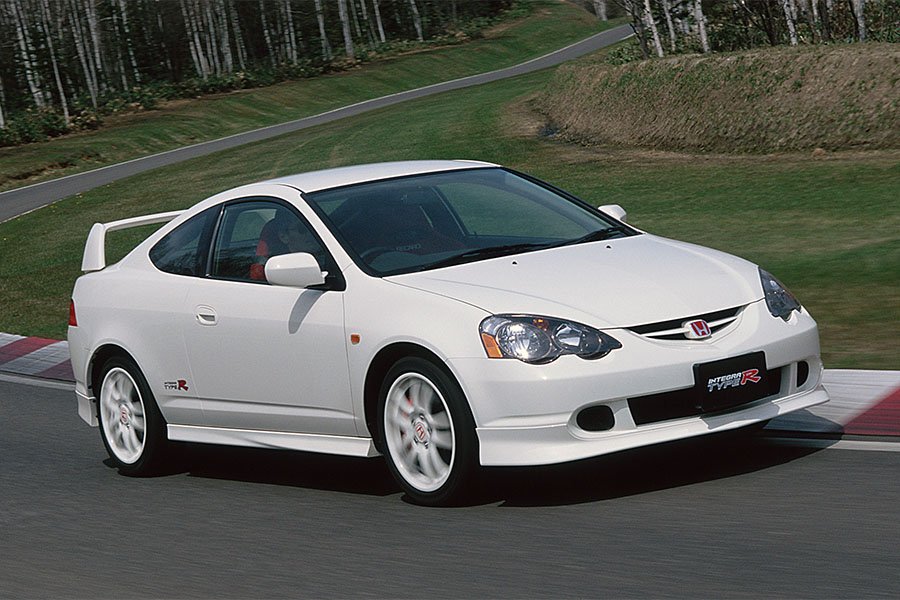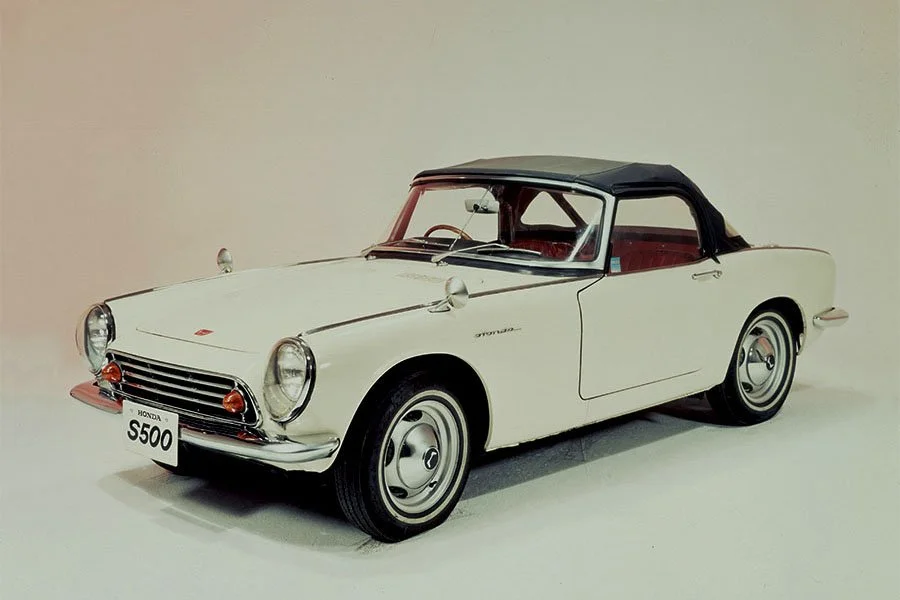Guide: Goodbye Hot Integra - a Historical & Technical Appraisal of the Honda Integra DC5 Type R
/BACKGROUND
Having first appeared on an uprated iteration of the critically acclaimed NSX in late 1992, Honda’s Type R moniker was subsequently used for a range of hardcore performance-oriented models that quickly came to be regarded among the finest drivers’ cars of their era.
In addition to the flagship NSX, Type R versions of the Accord, Integra and Civic were all introduced during the mid-to-late 1990s; road testers lauded each for its class-leading dynamics while customers at home and abroad eagerly sought out these instant classics.
In September 2000, Honda launched its seventh generation Civic, the EP3, which was offered in a variety of body styles with myriad engines.
This was in turn followed by a fourth generation Integra, the DC5, in April 2001.
Conceived as a more upmarket and slightly sportier version of the Civic upon which it was based, the Integra had been a strong seller ever since it first arrived in 1985. Meanwhile, the DC2 Type R version produced from 1995 to 2000 came to be considered one of the best compact performance cars of all time.
Six months after the Integra DC5 arrived, Honda unveiled their highly anticipated Type R version at the Tokyo Motor Show in October 2001.
It followed the familiar Type R theme of less weight, extra power and a more driver-focused chassis set-up. Compared to the outgoing model, the new DC5 most notably brought with it an engine that was around 200cc larger, a much-improved VTEC system and a six instead of five-speed gearbox.
Unfortunately, Honda only offered the DC5 Integra Type in Japan, New Zealand and Australia (the latter pair in slightly watered down trim). As it was built exclusively in right-hand drive, a few grey market market cars also found their way to the UK where the previous DC2 had been a strong seller.
All cars were assembled at Honda’s Suzuka plant.
Production got underway immediately for the 2002 model year.
CHASSIS
The DC5’s galvanised steel bodyshell was designed to be much stiffer than the outgoing DC2 variant. Although the new model was 20mm longer than before (4400mm), the wheelbase (2570mm), width (1695mm) and height (1320mm) remained the same.
Unlike previous iterations of the Civic / Integra platform, the new FP3 and DC5 switched to a MacPherson strut instead of double wishbone front suspension layout which resulted in a much roomier cockpit. A double wishbone set-up was retained at the back.
Upgrades fitted to the new Integra Type R compared to lesser DC5 variants included stiffer springs and dampers, an aluminium front strut brace and a thicker rear anti-roll bar.
To save weight, aluminium was used for the lower control arms (and front bumper beam).
The brake system comprised 300mm diameter vented discs up front with four-piston Brembo calipers. Out back were 260mm solid discs with single piston calipers. High performance Ferodo pads were fitted all round.
7 x 17-inch five twin spoke alloy wheels were unique additions and originally came shod with Bridgestone Potenza RE040 tyres.
Variable assistance power steering was fitted as standard.
A 50-litre fuel tank from the regular DC5 was fitted underneath the rear seat.
ENGINE / TRANSMISSION
In the engine bay was the latest iteration of Honda’s formidable K-series power unit.
The transversely-mounted K20A High Performance inline four cylinder motor fitted to the DC5 Type R featured an aluminium block and head, dual overhead camshafts, four valves per cylinder and wet-sump lubrication.
Instead of a conventional distributor-based ignition timing system, the K20A motor adopted a computer-controlled coil-on-plug arrangement that allowed the ECU to control ignition timings based on various sensor inputs.
There was also a new intelligent VTEC system dubbed i-VTEC that now electronically adjusted valve lift, valve duration and valve timing to provide a flatter torque curve than before.
Other trick parts found on the K20A motor included roller rockers on the cylinder head to reduce friction, high compression pistons, high-tensile strength connecting rods, stiffer valve springs, high-lift hollow camshafts, a short isometric intake manifold, dual exhaust manifolds, a high-strength crankshaft and a variable-valve silencer.
Displacement was 1998cc thanks to bore and stroke measurements of 86mm apiece. This represented a gain of 201cc compared to the B18C motor fitted to the previous Integra Type R. However, despite its larger displacement, the K20A weighed in at 10kg less than the old B18C.
Fuel-injection was courtesy of Honda’s latest PGM system and the compression ratio was set at 11.5:1.
Peak output was 217bhp at 8000rpm and 152lb-ft at 7000rpm with the i-VTEC engaging at 6000rpm.
For comparison, the previous DC2 Integra Type R had pumped out 197bhp at 8000rpm and 133lb-ft at 7500rpm.
The DC5 Integra Type R produced 5bhp more and an additional 3lb-ft than the similarly-engined FP3 Civic Type R thanks to its new free-flow exhaust. It also had a 200rpm higher rev limiter.
Transmission was through the front wheels via a brand new, more compact six-speed manual close-ratio gearbox, a single-plate clutch and helical limited-slip differential.
Multiple synchromesh cones were adopted for all gears (a triple-cone for first and second with a double cone for third through sixth). Honda also fitted a forged chromoly flywheel that helped to reduce inertia, improved acceleration and gave a faster throttle response.
BODYWORK
Compared to regular DC5 Integras, the Type R came with an array of special parts designed to improve the looks and aerodynamics.
Up front, Honda fitted a new bumper assembly with enlarged intakes and a deeper chin spoiler. The duct between the High-Intensity Discharge projector headlights came with a body coloured instead of black badge plinthe and matching whiskers.
Down each flank were deep crossover side skirts.
At the back of the car was a trunk lid-mounted basket handle spoiler, a bumper with extended apron and a wiper-less windscreen.
Red-backed Honda badges were fitted fore and aft, a Type R badge was added to the tailgate and Integra Type R decals were adhered to the rear fenders.
Customers could initially choose from one of five exterior colours: Championship White, Milano Red, Nighthawk Black Pearl, Satin Silver Metallic or Eternal Blue Pearl.
Body coloured wheels were fitted on Championship White cars with silver used for all other shades.
Body panels were steel with the exception of the bumpers, skirts and rear spoiler which were fashioned from plastic composite.
INTERIOR
Inside, the Type R’s most obvious new feature was a pair of manually-operated and heavily bolstered Recaro bucket seats upholstered with suede-like outer sections and woven fabric centres.
There was also a small diameter leather Momo steering wheel with red stitching and red-backed Honda logo. The gear gaiter was trimmed to match.
Instrumentation comprised four red-on-black analogue dials housed in a curved binnacle directly ahead of the driver. The 9000rpm rev counter was a special Type R feature. It was flanked by a 180kph speedometer plus smaller read outs for water temperature and fuel.
Located at the top of the central control panel were three dials to control the air-conditioning system. Underneath was a blanked-off panel where the audio system would normally reside.
Other special equipment included a new polished aluminium shift knob, matching handbrake lever knob, Integra Type R-branded sill plates and drilled aluminium pedals with matching footrest.
To save wight, the level of soundproofing was much-reduced and the audio system, side airbags and vanity mirrors were deleted.
However, air-conditioning, electric mirrors, electric mirrors, central locking and driver / passenger airbags were all retained and fitted as standard.
Seat and door panel upholstery came in choice of three colours: black, red or blue.
Carpet came in a choice of black or red.
OPTIONS
Other than exterior and interior colours, options were pretty limited.
Customers could re-instate the audio system, request an alarm / immobiliser and specify the C Package bundle that comprised a rear wiper, electric folding mirrors and privacy glass for the rear quarter windows.
WEIGHT / PERFORMANCE
Despite its lighter engine and more compact gearbox, the DC5 Integra Type R weighed 110kg more than its DC2 predecessor primarily as a consequence of its beefier bodyshell.
Top speed was now 150mph (up from 145mph) but the 0-62mph time was two-tenths slower at 6.4 seconds.
OCEANIA VERSION
DC5 Integra Type Rs destined for Australia and New Zealand were fitted with the K20A2 motor which ran a reduced 11.0:1 compression ratio (down from 11.5:1) and a PRB instead of PRC intake manifold.
Peak output was 200bhp at 7400rpm and 142lb-ft at 6000rpm (down from 217bhp at 8000rpm and 152lb-ft at 7000rpm respectively).
The redline was reduced (from 8400rpm to 7800rpm) and the i-VTEC now kicked in at 5800rpm (as opposed to 6000rpm).
These cars also lacked the Brembo front brake system and came with 16-inch five-spoke wheels (painted gunmetal or white).
2004 MODEL YEAR
In September 2003 (for the 2004 model year) Honda updated the Integra Type R with body colour instead of black windscreen washer nozzles
Rear privacy glass now became a stand-alone option separate from the C Package bundle.
A choice of two Mini Disc audio system options were also introduced: one with four speakers and the other with six speakers and an integrated six-disc CD changer.
2005 MODEL YEAR
More far-reaching changes were made for the 2005 model year (production of which started in September 2004).
Honda gave the car a face-lift by adding new bumper assemblies, new skirts, new head and tail lights and a new front grille complete with Type R badge and no whiskers.
Under the skin, the bodyshell was made stiffer with reinforced suspension and pedal mountings. Uprated springs, dampers and bushes were fitted, the steering was made more more responsive and a larger brake master cylinder was installed.
Inside, Honda added black-on-white gauges and titanium instead of aluminium trim. Titanium inserts were added to the dash.
An alarm / immobiliser was now automatically fitted as standard.
There were also several new options to choose from: a high or low-line rear spoiler, key-less go, an HDD satellite-navigation system and auto-levelling headlights.
Two new colours became available: Alabaster Silver Metallic (which replaced Satin Silver Metallic) and Vivid Blue Pearl (which replaced Eternal Blue Pearl).
END OF PRODUCTION
Production of the DC5 Integra Type R was discontinued in June 2005.
By this time, 12,247 examples of the Japanese Domestic Market variant had been completed, a disappointing figure that led Honda not to offer a replacement.
In terms of the de-tuned Oceania version, precise figures are currently unknown but somewhere in the region of 2000-3000 seems likely.
Text copyright: Supercar Nostalgia
Photo copyright: Honda - https://global.honda/












































